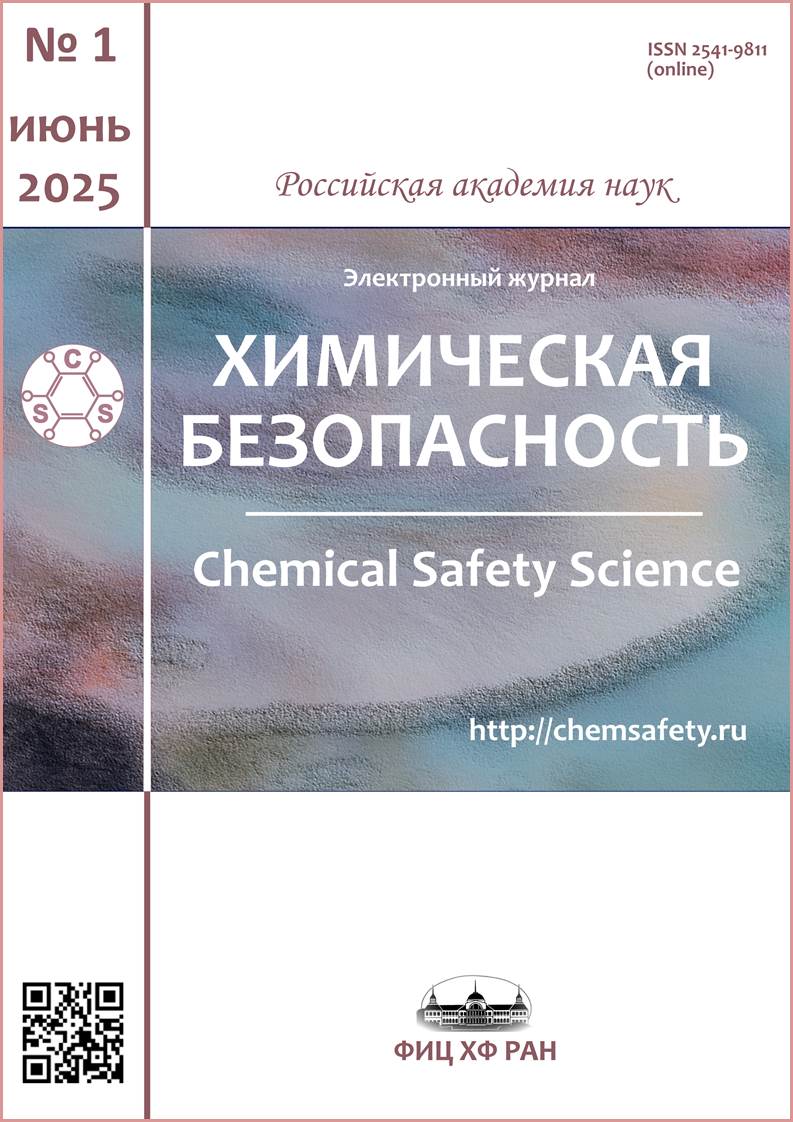Toxicological evaluation with determination of hazard classes of laureth-4-phosphate-based adjuvant using experimental and computational methods
Abstract
A preparation based on ethoxylated alcohol, widely used in agricultural production as an adjuvant (surfactant) together with pesticides of chemical synthesis, was chosen as an object of study of toxicity parameters. The paper presents original data of toxicological studies, carried out by experimental and calculated method, to determine the hazardous properties of adjuvant based on laureth-4-phosphate, used in the agricultural sector of the country together with pesticides of chemical synthesis. Also the paper reflects information on the classification of hazards of the studied chemical products for human health, obtained as a result of application of two different methods - calculated and experimental, for assessment by parameters of acute intragastric toxicity and acute toxicity when applied to the skin, assessment by parameters of allergy hazard.
One of the main criteria in selecting an approach for toxicological studies of chemical products is the completeness of available data on the hazardous properties of its components (toxicological profile). the use of a combined approach in complex toxicological studies of chemical products (using experimental and computational methods of establishing hazard classes) not only allows to obtain the most complete and comprehensive assessment of preparations in terms of hazardous properties for human health, but also provides a harmonious and comprehensive assessment of their properties.
References
Istomin, A. V., Rumyantseva, L. A., Vetrova, O. V., & Mikhailov, I. G. (2017). Study of the toxic effect of a new agrochemical. Toxicological Bulletin. (3), 144 (in Russ). https://cyberleninka.ru/article/n/izuchenie-toksicheskogo-deystviya-novogo-agrohimikata (accessed 25.03.2025).
Petrova, S. Y., & Gomolko, T. N. (2023). Toxicologo-hygienic studies with risk assessment in the use of herbicide containing diflufenican, metribuzin and florasulam under agroindustrial complex conditions. Chemical Safety Science. 7(1), 184–197 (in Russ). https://doi.org/10.25514/CHS.2023.1.24014. (accessed 25.03.2025).
Kamliuk, S.N., Petrova, S.Y., Ilyukova, I.I., Gomolko, T.N., & Lappo, L.G. (2024). Toxicological and hygienic evaluation of seed dressing based on prochloraz, triticonazole and azoxystrobin for safe use in agriculture / Proceedings of the All-Russian Scientific and Practical Conference with international participation “Healthy Environment”. Ufa. 261–264 (in Russ).
Brankov, M, Simić, M, Vukadinović, J, Zarić, M, Tataridas, A, Božinović, S, & Dragičević, V. (2025). Could adjuvants serve as an agroecological tool? Frontiers in Agronomy. 6. 1–6. DOI: https://doi.org/10.3389/fagro.2024.1523208.
Petrova, S. Yu., Kamlyuk, S. N., Ilyukova, I. I., Gomolko, T. N. (2024). Determination of tentatively safe level of exposure to iprodione - the active ingredient of plant protection agent in the atmospheric air of populated areas. Proceedings of the 24th International Scientific Conference “Sakharov Readings 2024: environmental problems of the XXI century”. Minsk: data-processing center of the Ministry of Finance, P. 1, 218–221 (in Russ).
Polli, E. G., Alves, G. S., de Oliveira, J. V., Kruger, G. R. (2021). Physical-Chemical Properties, Droplet Size, and Efficacy of Dicamba Plus Glyphosate Tank Mixture Influenced by Adjuvants. Agronomy. 11, 1321. https://doi.org/10.3390/agronomy11071321.
Mirenkov, Y. A. Saskevich, P. A. (2024). Chemical plant protection. A course of lectures : teaching manual. Gorki : BGSKhA (in Russ).
Requirements for experimental studies for primary toxicological assessment and hygienic regulation of substances: instruction 1.1.11-12-35-2004 : Collection of normative documents. Minsk: RTSGEiOH, 2004. 43 p. (in Russ).
Korobeinikova, E. P., Komarova, E. F. (2016). Laboratory animals - biomodels and test systems in fundamental and preclinical experiments in accordance with the standards of good laboratory practice (NLP/GLP). Journal of basic medicine and biology. (1) (in Russ). URL: https://cyberleninka.ru/article/n/laboratornye-zhivotnye-biomodeli-i-test-sistemy-v-fundamentalnyh-i-doklinicheskih-eksperimentah-v-sootvetstvii-so-standartami. (accessed 25.03.2025).
Sysa, A. G., Zhivitskaya, E. P. (2018). Statistical analysis in biology and medicine. Minsk : data-processing center of the Ministry of Finance (in Russ).
Bavrina, A. P. (2021). Modern rules of application of parametric and nonparametric criteria in statistical analysis of biomedical data. Medical Almanac. 1(66), 64–73 (in Russ). URL: https://cyberleninka.ru/article/n/sovremennye-pravila-primeneniya-parametricheskih-i-neparametricheskih-kriteriev-v-statisticheskom-analize-mediko-biologicheskih/viewer. (accessed 25.03.2025). (in Russ).
Requirements for pesticides and agrochemicals. Unified sanitary-epidemiological and hygienic requirements for goods subject to sanitary-epidemiological supervision (control). Section 15 (in Russ). https://eec.eaeunion.org/upload/files/depsanmer/P2_299/%d1%80%d0%b0%d0%b7%d0%b4%d0%b5%d0%bb%2015%20%d0%95%d0%a1%d0%a2.pdf. (accessed 25.03.2025).
GOST (State Standard) 32419-2022. Hazard classification of chemical products. General requirements: Moscow: Russian Institute of Standardization, 2023. 35 р. (in Russ).
GOST (State Standard) 32423-2013. Hazard classification of mixed chemical products on the effect on the organism. Moscow : Standardinform, 2014. 13 p. (in Russ.)
GOST (State Standard) 31340-2022. Warning labeling of chemical products. General requirements. Moscow: Russian Institute of Standardization, 2022. 57 р. (in Russ).
Globally Harmonized System of Classification and Labelling of Chemicals (GHS). Tenth revised edition. (2023). United Nations: New York and Geneva. https://unece.org/sites/default/files/2023-07/GHS%20Rev10e.pdf (accessed 25.03.2025).
PubChem. Compound Summary. Laureth-4 phosphate. https://pubchem.ncbi.nlm.nih.gov/compound/Laureth-4-phosphate. (accessed 25.03.2025).
PubChem. Compound Summary. Butylated Hydroxytoluene. https://pubchem.ncbi.nlm.nih.gov/compound/31404. (accessed 25.03.2025).
PubChem. Compound Summary. Phosphoric Acid. https://pubchem.ncbi.nlm.nih.gov/compound/1004. (accessed 25.03.2025).
PubChem. Compound Summary. Lauryl Alcohol. https://pubchem.ncbi.nlm.nih.gov/compound/8193. (accessed 25.03.2025).
Russell, W. M. N., Bunch. R. L. (1959). The principles of humane experimental technique. London, Methuen. Р. 55. https://caat.jhsph.edu/the-principles-of-humane-experimental-technique/. (accessed 25.03.2025).
Copyright (c) 2025 Svetlana Yu. Petrova, Svetlana M. Kamliuk, and Tatyana N. Gomolko

This work is licensed under a Creative Commons Attribution-NonCommercial 4.0 International License.












